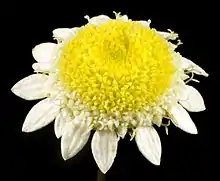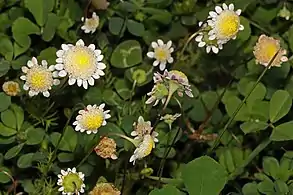| Cotula turbinata | |
|---|---|
 | |
| Scientific classification | |
| Kingdom: | Plantae |
| Clade: | Tracheophytes |
| Clade: | Angiosperms |
| Clade: | Eudicots |
| Clade: | Asterids |
| Order: | Asterales |
| Family: | Asteraceae |
| Genus: | Cotula |
| Species: | C. turbinata |
| Binomial name | |
| Cotula turbinata | |
| Synonyms[1] | |
|
List
| |
Cotula turbinata (common name ganskos in South Africa,[2] funnel weed in Western Australia)[3] is a herb in the Asteraceae family native to the Cape Province, but found in India and in Australia[1]
Cotula turbinata is an annual herb, growing to heights of 5 cm to 40 cm,[3] and has hairy stems.[4] In Western Australia, it grows on sandy soils, in lawns and on road verges, where its white and yellow flowers may be seen from July to October.[3]
It was first described by Carl Linnaeus in 1753.[1][5] The genus name, Cotula, comes from the Greek kotule meaning "small cup" and refers to the cupped area at the base of the leaves,[6] while the specific epithet, turbinata, is a botanical Latin adjective, which describes the flower as having the shape of a top.[7]
Gallery
References
- 1 2 3 "Cotula turbinata L. | Plants of the World Online | Kew Science". Plants of the World Online. Retrieved 7 January 2021.
- ↑ "Threatened Species Programme | SANBI Red List of South African Plants: Cotula turbinata". redlist.sanbi.org. Retrieved 7 January 2021.
- 1 2 3 "Cotula turbinata". FloraBase. Western Australian Government Department of Biodiversity, Conservation and Attractions.
- ↑ I.R. Thompson (2020). "Cotula turbinata". Flora of Australia. Canberra: Australian Biological Resources Study, Department of Agriculture, Water and the Environment. Retrieved 8 January 2021.
- ↑ Caroli Linnæi (1753), Species Plantarum: Exhibentes plantas rite cognitas ad genera relatas (in Latin), vol. 2, p. 892, Wikidata Q21856107
- ↑ "Cotula turbinata". New Zealand Plant Conservation Network. Retrieved 7 January 2021.
- ↑ "turbinatus,-a,-um". www.plantillustrations.org. Retrieved 7 January 2021.

.jpg.webp)
